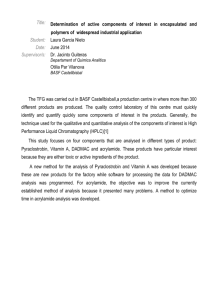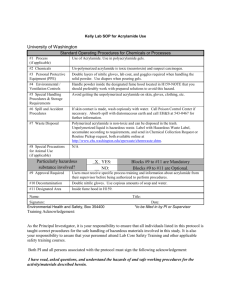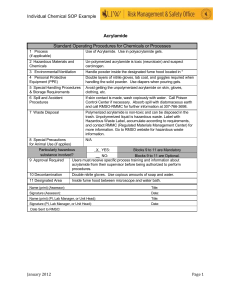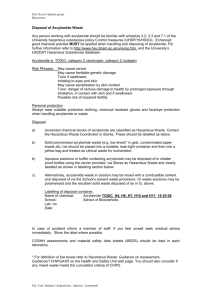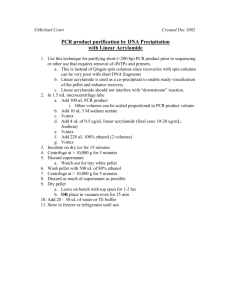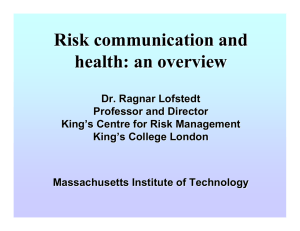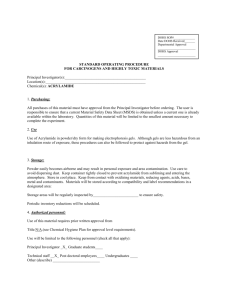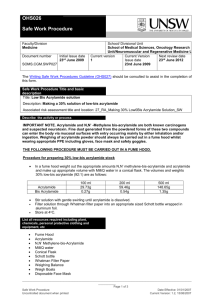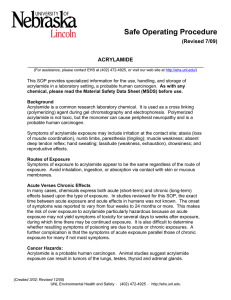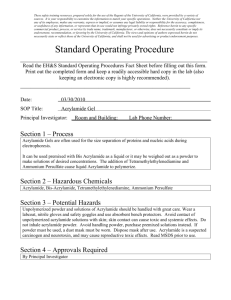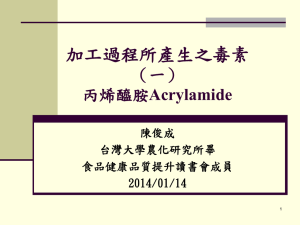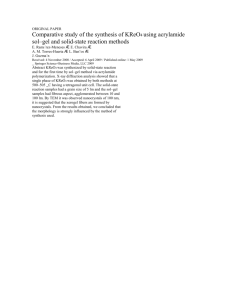Acrylamide - WSU Environmental Health & Safety
advertisement
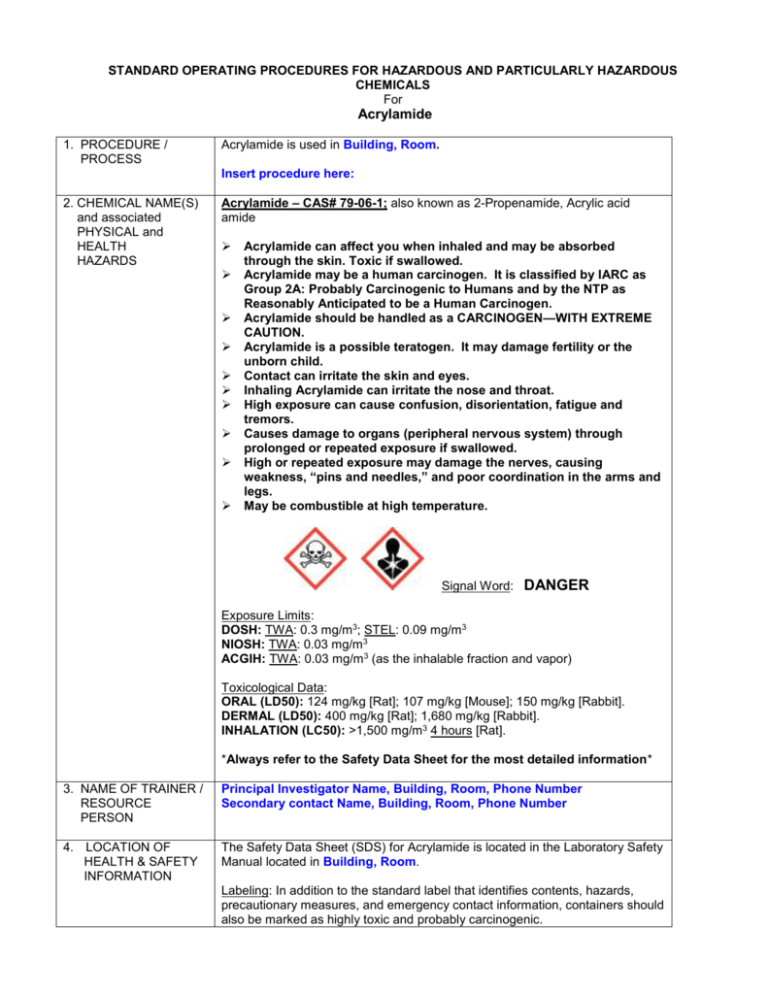
STANDARD OPERATING PROCEDURES FOR HAZARDOUS AND PARTICULARLY HAZARDOUS CHEMICALS For Acrylamide 1. PROCEDURE / PROCESS Acrylamide is used in Building, Room. Insert procedure here: 2. CHEMICAL NAME(S) and associated PHYSICAL and HEALTH HAZARDS Acrylamide – CAS# 79-06-1; also known as 2-Propenamide, Acrylic acid amide Acrylamide can affect you when inhaled and may be absorbed through the skin. Toxic if swallowed. Acrylamide may be a human carcinogen. It is classified by IARC as Group 2A: Probably Carcinogenic to Humans and by the NTP as Reasonably Anticipated to be a Human Carcinogen. Acrylamide should be handled as a CARCINOGEN—WITH EXTREME CAUTION. Acrylamide is a possible teratogen. It may damage fertility or the unborn child. Contact can irritate the skin and eyes. Inhaling Acrylamide can irritate the nose and throat. High exposure can cause confusion, disorientation, fatigue and tremors. Causes damage to organs (peripheral nervous system) through prolonged or repeated exposure if swallowed. High or repeated exposure may damage the nerves, causing weakness, “pins and needles,” and poor coordination in the arms and legs. May be combustible at high temperature. Signal Word: DANGER Exposure Limits: DOSH: TWA: 0.3 mg/m3; STEL: 0.09 mg/m3 NIOSH: TWA: 0.03 mg/m3 ACGIH: TWA: 0.03 mg/m3 (as the inhalable fraction and vapor) Toxicological Data: ORAL (LD50): 124 mg/kg [Rat]; 107 mg/kg [Mouse]; 150 mg/kg [Rabbit]. DERMAL (LD50): 400 mg/kg [Rat]; 1,680 mg/kg [Rabbit]. INHALATION (LC50): >1,500 mg/m3 4 hours [Rat]. *Always refer to the Safety Data Sheet for the most detailed information* 3. NAME OF TRAINER / RESOURCE PERSON Principal Investigator Name, Building, Room, Phone Number Secondary contact Name, Building, Room, Phone Number 4. LOCATION OF HEALTH & SAFETY INFORMATION The Safety Data Sheet (SDS) for Acrylamide is located in the Laboratory Safety Manual located in Building, Room. Labeling: In addition to the standard label that identifies contents, hazards, precautionary measures, and emergency contact information, containers should also be marked as highly toxic and probably carcinogenic. 5. PROTECTIVE EQUIPMENT Wear chemical safety goggles, nitrile rubber gloves and a fully-buttoned lab coat. Wash hands after removing gloves. Work within a properly functioning, certified laboratory chemical fume hood. 6. WASTE DISPOSAL PROCEDURES Waste Acrylamide and its solutions must be managed as Dangerous Waste. It should be collected in a sealable, compatible waste container. The container should be stored away from incompatible materials such as acids, oxidizing agents, iron and iron salts, copper, brass, and free radical initiators. A completed Dangerous Waste label should be attached when waste is first added to the container. When container is full or no longer being used complete a Chemical Collection Request Form, and deliver to the Waste Accumulation Area Operator at Building, Room, Phone Number. Empty Acrylamide containers must be managed as Dangerous Waste. Do not rinse out the container, simply attach a completed Dangerous Waste label, complete a Chemical Collection Request Form, and deliver to the Waste Accumulation Area Operator at Building, Room, Phone Number. 7. DESIGNATED AREA INFORMATION The acrylamide is stored and dispensed in Building, Room. Always work in a properly functioning, certified laboratory chemical fume hood. The designated area(s) should be shown on the floor plan in the laboratory’s Chemical Hygiene Plan. 8. DECONTAMINATION PROCEDURES Upon Accidental Exposure: In case of eye contact, flush eyes with copious amounts of water at an emergency eyewash station for at least 15 minutes and seek medical attention. In case of skin contact, flush skin with copious amounts of water for 15 minutes and seek medical attention. For exposure over a large portion of the body, remove clothing and shoes and rinse thoroughly in an emergency shower for at least 15 minutes. Seek medical attention. In case of inhalation, move person to fresh air and immediately seek medical attention. In case of ingestion, immediately seek medical attention and follow instructions on SDS. Upon Accidental Release: Large Spill: If a large amount of acrylamide is spilled outside the fume hood, immediately evacuate and secure area and call 911 to contact EH&S. Small Spill: If a small amount of acrylamide is spilled (it can be cleaned up in 10 minutes) and you have been appropriately trained to clean it up, you may do so. Trained personnel should wear at the minimum nitrile rubber gloves, chemical safety goggles, and a fully-buttoned lab coat. Additional PPE such as respirators may be necessary depending upon material and concentration. (Note: You must be medically cleared, fit tested and enrolled in WSU’s Respiratory Protection Program to wear a respirator.) If it is necessary to use a respirator and personnel are not cleared to wear a respirator and not trained to appropriately clean up the spill, the employee should immediately evacuate, secure area, and call 911 to contact EH&S. Use appropriate tools to collect material and place material in an appropriate waste disposal container (resealable bag, etc.) and dispose of as hazardous waste (see above WASTE DISPOSAL PROCEDURES). As with all accidents, report any exposure as soon as possible to your Principal Investigator or Supervisor. Additional health and safety information on acrylamide can be obtained by referring to the SDS or by calling the EH&S Office (335-3041). 9. SPECIAL STORAGE AND HANDLING PROCEDURES Store in a cool, dry, well-ventilated area away from sources of sparks, flame, sunlight or other sources of heat or ignition. Store segregated from incompatible chemicals (below). Keep container tightly closed. Do not ingest. Store highly toxic or infectious materials separately in a locked safety storage cabinet or room. Keep away from incompatible chemicals such as acids, oxidizing agents, iron and iron salts, copper, brass, and free radical initiators. Light sensitive. May polymerize on exposure to light. Certification of Hazard Assessment Is this document a certification of Hazard Assessment for the processes identified within? Yes No If yes, provide the name of the person certifying the Hazard Assessment and the date it was performed: ____________________________________________________________________________________ Name Date The location of the Hazard Assessment is indicated in the document preceding this form. Certificate of Employee Training Name of person providing training for employees working with this process: ___________________________________________________________________________________ The following employees have been trained in when, where and how to use selected PPE, the maintenance, limitations and disposal of the PPE selected, and have demonstrated the correct use of the PPE selected on the reverse of this certification. Name Date Trained ________________________________________ _______________________________ ________________________________________ _______________________________ ________________________________________ _______________________________ ________________________________________ _______________________________ ________________________________________ _______________________________ ________________________________________ _______________________________ ________________________________________ _______________________________
